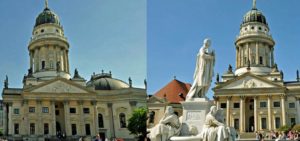
Berlin’s Deutscher Dom and Französischer Dom (Photos by Don Knebel)
In about 1688, Frederick I of Prussia created a new outdoor market in an area of Berlin inhabited by large number of Huguenots (French Protestants) who had fled persecution by French Roman Catholics. In 1701, Frederick gave the refugees permission to build a church at the northern end of the market, where they worshipped in the Reform tradition established by John Calvin. When indigenous Protestants, who worshipped in the tradition established by Martin Luther, demanded their own church, Frederick allowed them to build a Lutheran church at the southern end of the market. In 1785, Frederick II commissioned Carl von Gontard, a local Huguenot architect, to design and build virtually identical Palladian-style domed towers adjacent to the original churches. Beginning in 1818, a theatre, its exterior design complementing the domed towers, was erected along the western side of the plaza. The northern church became known informally as Französischer Dom (French Dome) and the southern church became known as Deutscher Dom (German Dome). The plaza itself was called Gendarmenmarkt after the military stables that once existed on the site.
Allied bombing during World War II severely damaged the buildings in Gendarmenmarkt. The East German government restored them all during the 1970s. Today Französischer Dom is still used as a church and includes a Huguenot Museum. Deutscher Dom, no longer a church, houses an exhibit about German parliamentary history. The theatre is used as a concert hall for one of Berlin’s orchestras, which performs open air concerts from the hall’s steps during the summer. In the winter, Gendarmenmarkt once again becomes a colorful outdoor market, with vendors selling Christmas and craft items from decorated wooden booths.